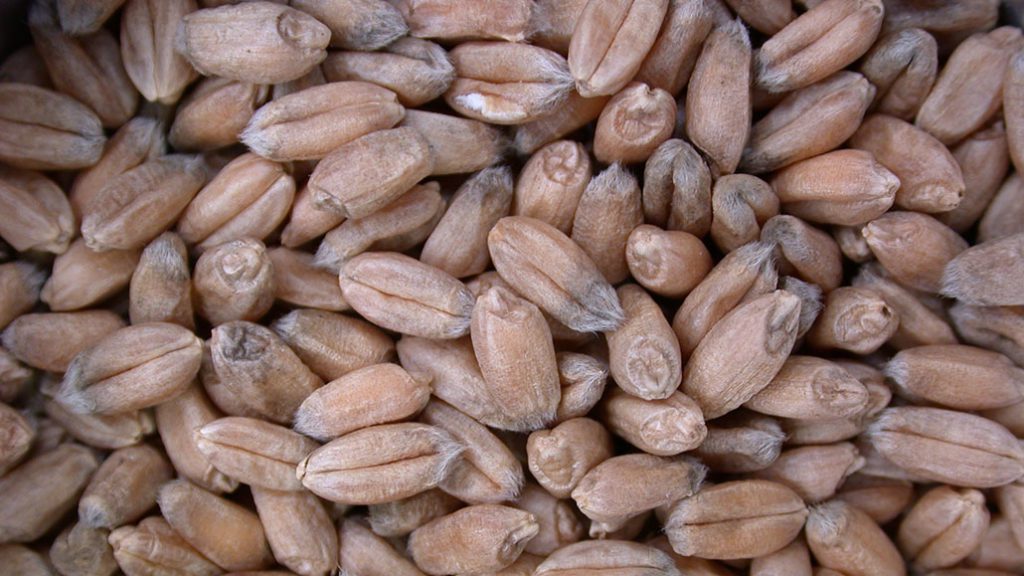Mildew infected wheat
THE IMPACT ON THE MILLING AND BAKING INDUSTRY

IN CANADA, VISUAL grading standards are used to help determine the value of wheat. Grades are assigned based on a sample’s ability to meet tolerances for various grading factors. The tolerable levels of the visual factors inspected for are in place because a downgrade can severely impact perceived flour quality, specifically regarding gluten strength.
Gluten functionality is unique in wheat because it is the only cereal to allow for an elastic gluten network that helps trap the carbon dioxide formed during the fermentation stage of bread baking. If the gluten is weakened, its effectiveness would be compromised.
The impact of mildew infection on flour quality is the cause of frequent debate. Specifically, whether the tolerable levels of mildew infection are too low and whether those low limits have any impact on the flour quality at all. The financial impact this can have on farmers if the downgrade is a result of mildew infection is significant and the reason this topic continues to be raised. In 2016, recognising the financial impact downgrading was having on farmers, the Canadian Grain Commission (CGC) revised the guidelines to allow for more presence of mildew across most wheat classes.
INFECTED GRAIN
Mildew is a fungus which, when conditions are wet enough, infects the unthreshed heads of various cereal crops. Its presence is evident by the grey colour that appears on the brush end of the kernel. It may also be detected migrating towards the germ-end of the kernel along the crease and surface. It should not be confused with the disease powdery mildew, which is found on the leaves and reduces yield.
CGC research demonstrated the main impact of mildew infection on flour is its appearance as it is greyer than the traditional white expected. For some products, such as udon and ramen noodles, a bright, white colour is an important aesthetic quality and, some may argue, is just as important as the noodle texture and flavour. The discoloured bran coat of the wheat can also be noticed in products where whole wheat flour is used, such as breakfast cereals and whole wheat bread. It is worth noting that CGC studies also showed that the gluten strength in the dough made from flour milled from mildew infected wheat was only mildly affected.
MILLING CHALLENGES
To combat the effect of mildew infection on flour colour, millers can reduce their flour extraction rate to make the flour appear brighter but at the financial cost of obtaining less flour from each kernel of wheat. Typically, wheat with high levels of mildew have a lower test weight and can therefore already lower the flour extraction capability.
In southern Ontario, soft red winter wheat is the main wheat class grown. This class is more susceptible to mildew infection, and the presence of mildew is a key indicator for millers in this region as it relates to the falling number test. Falling number is commonly performed on wheat to measure the levels of alpha amylase present in a sample of ground wheat. Alpha amylase is an enzyme in wheat which plays an important role in the germination process as it breaks down starch into sugars used in this process. The falling number test simply measures the rate at which the starch in a sample is broken down by the enzyme; the quicker the test takes to complete, the more alpha amylase present in the sample of wheat.
High levels of alpha amylase in wheat is a result of germination having been initiated. Prior to germination, alpha amylase is present in low concentrations and when conditions for sprouting are ideal, the levels of alpha amylase in the wheat spikes. This high concentration of alpha amylase in the wheat is transferred to the flour after milling.
Sprouted wheat with high levels of alpha amylase is detrimental to flour quality and its ability to produce a bread product meeting manufacturers’ quality standards. The flour milled from such wheat would cause the dough to be excessively sticky and difficult to handle in the production process. It also causes bread loaves to be small and dense, with a dark crust colour, and the loaves may even collapse after baking.
Since the falling number test result is not one of the CGC grading criteria, mildew damage is instead relied upon by most millers as only an indicator of possible early sprouting. With the severe impact sprouted wheat causes bakers, most mills add the falling number test to their quality assurance program to assure
its suitability.
Paolo Santangelo is the commercial manager of the Grains Analytical Testing Laboratory, a joint venture between Grain Farmers of Ontario and SGS Agriculture and Food. •
























